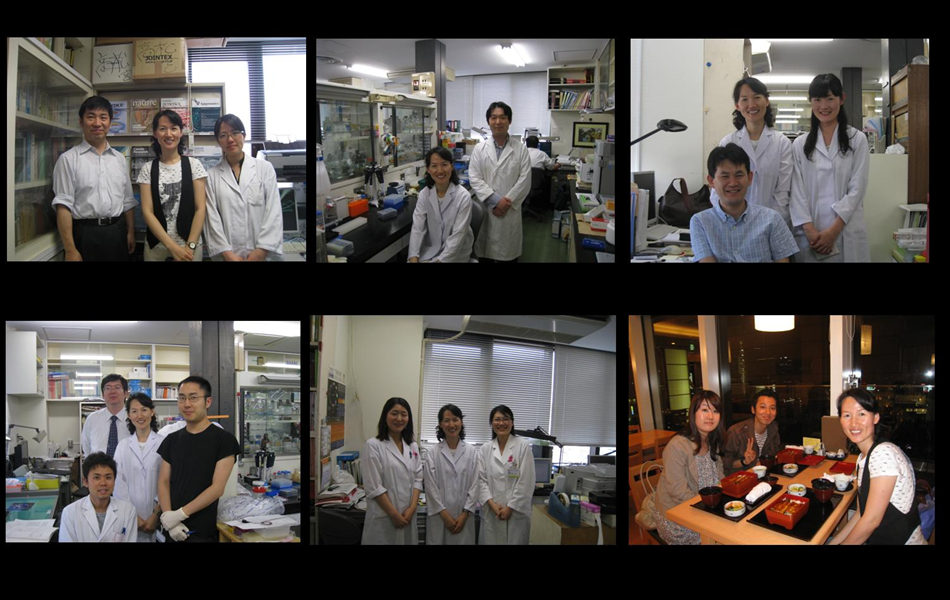Dr. Mirang Kim from Korea stays in NCCRI, Japan
A3 Foresight Program: Education Program for Young Researchers
Report of visit to NCCRI in Japan (May 19 – May 26, 2010)
Mirang Kim (Medical Genomics Research Center, Korea Research Institute of Bioscience & Biotechnology)
Host researcher
Dr. Toshikazu Ushijima (Chief, Carcinogenesis Division, National Cancer Center Research Institute)
Summary
I visited Dr. Ushijima’s Laboratory (Carcinogenesis Division, National Cancer Center Research Institute) in Tokyo, Japan from May 19 to May 26. The main purpose of this visiting was to learn the techniques “Chromatin immunoprecipitation (ChIP)” and “quantitative methylation specific PCR (qMSP)”. Both ChIP and qMSP are very important techniques of epigenetic study. I could compare the tools of Dr. Ushijima’s lab with ours. It was great experience for me, because I could talk with many young Japanese scientists about our studies, our lives, and our dreams.
Contents
1. Chromatin immunoprecipitation
ChIP is used to investigate the interaction between proteins and DNA in the cell. It aims to determine whether specific proteins are associated with specific genomic regions, such as transcription factors on promoters or other DNA binding sites. ChIP also aims to determine the specific location in the genome that various histone modifications are associated with, indicating the target of the histone modifiers.
(1) Buffers
(2) Sonication: Bioruptor UCD-250 (Cosmo Bio) in cold room
Set 2; 30s (sonication)
Set 1; 90s (interval)
10 cycles
(3) Dynabeads Protein A (Invitrogen, # 100.02D)
(4) Lysate (DNA 30μg): antibody 2μg
(5) Antibodies:
RNA pol II (Abcam, #ab5095)
H3K4me3 (Wako, monoclonal Ab #307-34813)
H3K9me2 (Wako, monoclonal Ab #308-32361)
H3K9me3 (Wako, monoclonal Ab #301-34833)
2. qMSP
qMSP is a simple rapid and inexpensive method to determine the methylation status of CpG sites. qMSP utilizes the sequence differences between methylated alleles and unmethylated alleles which occur after sodium bisulfite treatment. Primers for a given locus are designed which distinguish methylated from unmethylated DNA in bisulfite-modified DNA. Results are obtained immediately using real time PCR, without the need for further restriction or sequencing analysis.
(1) Primer
about 25mers, 2-4 CpG sites, 3'end "C", 2-5 "A", Tm 52-55℃
(2) Methyl DNA control:
SssI (NEB, #M0226L) treated genomic DNA
(3) Unmethyl DNA control:
Genomic amplified DNA (GenomiPhi HY DNA amplication Kit)
(4) PCR reaction (20μL):
DNA 1μL
10 X PCR buffer (15mM MgCl2) (Roche, #G11316) 2μL
2mM dNTPs (AB, UK #361827) 2μL
F primer (16mM) 1μL
R primer (16mM) 1μL
SYBR green I (1/1000 dil, Lonza, #50513) 0.1μL
AmpliTaq Gold (Roche KP2380) 0.2μL
DW 12.7μL
(5) Methylation level:
PMR= [(# of methylated fragments of a target in sample)/(# of Alu seq in sample)]/[(# of methylated fragments of a target in SssI treated DNA)/(# of Alu seq in SssI treated DNA)]
Photos and acknowledgments

I sincerely thank Dr. Ushijima for kind instruction and all arrangement about my visit to NCCRI. Dr. Takeshima taught me about ChIP and qMSP. Dr. Niwa taught me about qMSP and DNA methylation. Dr. Hattori helped me to go to museum and shopping. Yuko picked me up from the airport. I thank all laboratory members for warm hospitality.



